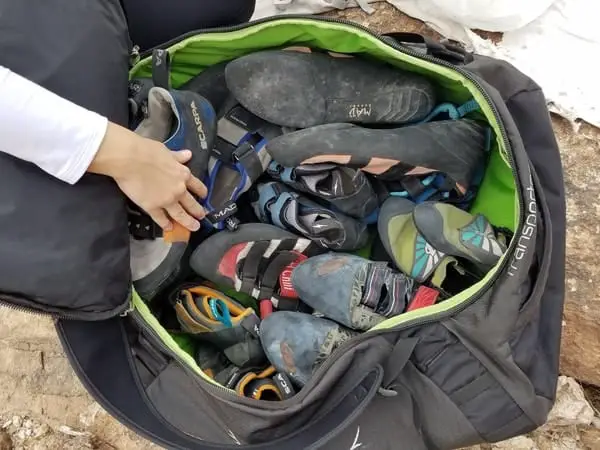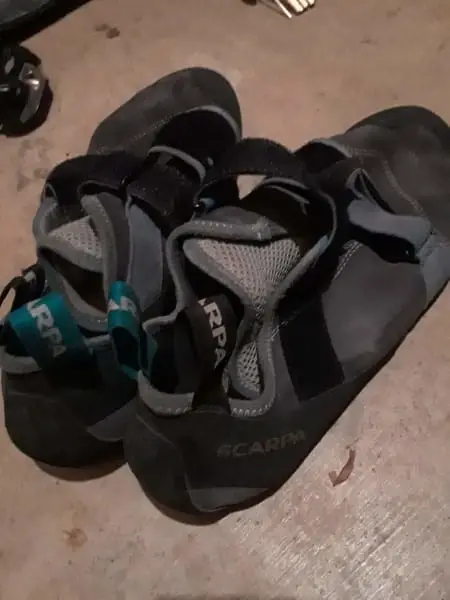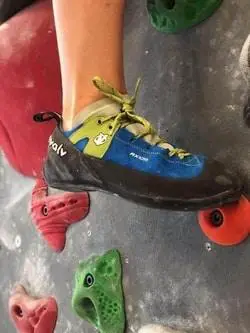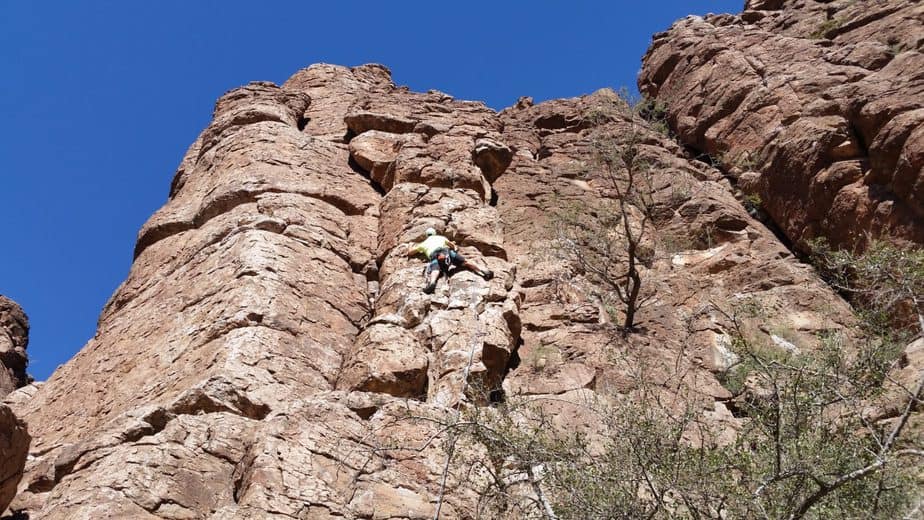The most important piece of gear that you need in order to go bouldering is a pair of rock climbing shoes. For other styles of climbing you need more gear, but rock climbing shoes are the first thing that you need. While climbing shoes have different features for different kinds of climbing, the basic shoe is designed to help balance all of your weight on as small a point as possible while still providing you the grip that you need.
Indoor Climbing Gyms charge $4-5 to rent rock climbing shoes. If you are looking to buy your own climbing shoes, you will pay as little as $40 for starter shoes, and up to $150 for professional shoes.
The real question you need to ask yourself is how much you want to pay for climbing shoes. As with other gear, you will generally get higher quality and more durability from more expensive shoes. If you are a beginner though, you probably won’t be able to tell as much between the expensive and the cheap shoes.

Can I Rock Climb Without Shoes?
Going rock climbing without shoes is like going for a hike in flip flops. It sort of works, but is a lot less fun and much more limiting. Plus, there’s a greater chance of minor injury. Most climbing gyms do not require you to use rock climbing shoes, but you really need them if you want to enjoy yourself. They will not allow you to climb barefoot, however, due to sanitary reasons.
I remember my mom taking me and my little brother to the climbing gym occasionally when we were little, and going a few times for cub scouts. Wanting to save money, they always elected to just pay for a day pass and harness rental and not spring for the shoes as well. It was always a lot of fun for us as kids to ‘rainbow’ climb the walls. At the time we didn’t understand that there were different difficulties and challenges to the routes!
Think about rock climbing without shoes like you would for bowling or ice skating, without the specific shoes you rent (or own, if you’re an enthusiast). Sure, you could make it work, but you won’t get the same experience and will significantly limit your potential. If you plan on doing any of these activities more than a few times each year, you’ll probably want to own your own pair of shoes.

Going without climbing shoes as a teenager or adult would be frustrating and painful. Tennis shoes can only support you on the biggest of holds, and the rubber is so soft and pliable that you would repeatedly slip off. Whenever you slip off of a hold, you hit your knees against the wall and end up bruised and scraped up.
If you’re going to go rock climbing, you really do need a pair of climbing shoes that fit well. Shoes that are too small will be extremely uncomfortable if you can even fit your feet inside, and shoes that are too big will be about as effective as tennis shoes. You will need climbing shoes if you intend to try any routes that are more difficult than about a 5.6 grade.
For More Information: Can I Rock Climb without Shoes?
Can I Rock Climb Outdoors without Shoes?
The same thing applies for climbing outdoors without climbing shoes. You could get by without them on the most basic routes that are less than vertical, but you need climbing shoes for the fun ones.
Climbing without climbing shoes will be extremely frustrating, will lead to skinned and banged up knees, and will make you not like climbing. If you’re bringing someone with you, you can bet they won’t like it if they don’t have shoes that fit well.
When I go Deep Water Soloing (Psicobloc) outdoors, I usually don’t bring shoes. Climbing barefoot is kind of fun, and is a different experience from regular climbing. While I do climb harder with shoes on, I like feeling the details in the rock. It usually scrapes or cuts up my feet, but is fun to do sometimes. For more info on deep water soloing and getting climbing shoes wet, read our article entitled Can Rock Climbing Shoes Get Wet?
How Much Should I Pay for Climbing Shoes?
If you are going to try climbing for the first time, it’s best to just rent a pair of shoes. You get a decent pair of shoes for a fraction of the price you would pay. Once you decide you’re hooked (probably about 10 minutes in!), then you definitely want to buy a pair of shoes.
It helps to justify the price by thinking of the money you’ll save by not renting each time. Plus, you don’t have to worry about the fungi and foot odors in the rentals! There’s nothing better than brand new climbing shoe rubber.
Climbing shoes come with slightly different features, from the aggressiveness of the toe to the softness of the rubber. It can be difficult to pick a good pair of shoes with all of the different features available. As you are starting out, you probably just want to go with a comfortable neutral pair of shoes.
Best Beginner Climbing Shoe-
In my experience climbing, and especially as I’ve paid attention at climbing gyms, the most common beginner climbing shoe is the La Sportiva Tarantulace . They come in at around $80, which is a real bargain for the brand name.
. They come in at around $80, which is a real bargain for the brand name.
They’re a very comfortable, neutral pair of climbing shoes and can be worn all day once they’re broken in. The Tarantulace shoes aren’t very aggressive, so don’t plan on climbing the world’s most difficult routes- but they provide enough support that you’ll stick to the walls and have a great time as you learn to climb.
One of the best things about this shoe is the La Sportiva brand (Why Sportiva is the best Climbing Shoe Brand). Most of their other shoes come in at well over $100, so this is nice peace of mind compared to other cheap shoes. These shoes are really designed to be durable, with 5mm rubber on the sole.
The tradeoff is that the thicker sole will last longer, but won’t give you quite the same feel for the rock- again, not an issue for a beginner. They are made of leather, but also have a synthetic outer support layer to keep them from stretching out too much. This enhances the comfort without sacrificing durability.
They do offer a men’s and a women’s version, and the only difference is the width of the shoes. They have a great sizing guide that is true to form, so take a look at that before you buy. If in doubt, try on a couple of different sizes and pick the one for you. If you’re looking to have a shoe that will last a long time and be comfortable, the La Sportiva Tarantulace is it!
Amazon: La Sportiva Tarantulace M
Amazon: La Sportiva Tarantulace W
Cheapest Beginner Climbing Shoe-
Climb X has emerged as a low-cost climbing gear company over the past few years. They aren’t a pioneer in the industry with new exciting designs or cutting-edge technologies, but they make solid gear targeted for beginners.
The Climb X Rave shoe is a prime example of this. It’s not going to fall apart after a few uses and the design and functionality is very similar to all of the best brands. These are definitely the low-cost version, but you probably won’t notice a difference as a beginner. The under $50 price point is hard to beat, and quickly justifies the ‘rent or buy’ decision.
shoe is a prime example of this. It’s not going to fall apart after a few uses and the design and functionality is very similar to all of the best brands. These are definitely the low-cost version, but you probably won’t notice a difference as a beginner. The under $50 price point is hard to beat, and quickly justifies the ‘rent or buy’ decision.
The velcro closure is nice so you can take them off quickly between routes, or leave them on. Again, follow the sizing guide- these ones don’t tend to stretch out very much. If you wear through your rubber after a while, it’s cheap enough to just buy a new pair or upgrade to something more aggressive instead of paying to resole these.
Amazon: Climb X Rave Strap 2019
Features of Climbing Shoes
There are a lot of things to consider when buying a pair of climbing shoes. Professional climbers own multiple pairs of shoes for different styles of climbing, from technical bouldering problems to multi-day big wall climbs.
To the average person, a lot of this is superfluous; but you ought to know what it is that you’re buying, and you can tailor your choice to your specific needs. These are the features you need to consider when picking out a new pair of climbing shoes:
- Sizing
- Closure
- Aggressiveness
- Materials
Sizing
When I first started climbing, the prevailing mentality was that you would climb the best in the tightest pair of shoes you could smash your toes into. The idea was that all of your weight would balance on the smallest surface area possible. It always became a debate for me as to which was more comfortable- taking my ski boots off after a full day of skiing, or taking my climbing shoes off after a multi-pitch route.
In the last 10 years or so, the mentality has changed. You still want your shoes to fit snugly, but they should fit more like a cinderella slipper. There shouldn’t be any space for your feet to slide around, but your toes should still have some bloodflow when you peel off the shoes.
Use your street shoes size as an anchor point, and go from there. Don’t assume that your climbing shoe size is the same, especially as you go between brands. Many brands use the European sizing chart, which can allow for smaller steps between sizes.
As you buy shoes, read the reviews from other customers to see how true they fit to the advertised sizing. Some brands have a reputation for being a bit bigger or smaller than others. This also applies to the narrowness of the shoes. Keep in mind that shoes with a leather upper will stretch out more than synthetic shoes. More info on materials to come-

Should I Buy Climbing Shoes with Laces or Velcro?
The closure system of your shoes is pretty important. There are three different styles of shoes out there right now, laces, velcro, and slippers. Each has distinct advantages and disadvantages.
Laces– Laced climbing shoes are the originals. The biggest advantage is that the closure system goes all the way up the shoe, so you can tighten or loosen it to get the perfect fit. You’ll see most of the professionals climbing in laced shoes because they can be molded better to the specific contours of your feet and to your exact needs.
They end up being slightly more comfortable than velcro shoes for this reason, and are generally better for long multi-pitch days. The downside is that they take a bit longer to put on, which can be annoying if you’re constantly removing them in between routes.
Velcro– Rock climbing shoes with velcro closures work really well too. Although they won’t fit your feet quite as well as laced shoes, they are much more convenient. I like velcro shoes for regular days at the crag or in the gym where you take your shoes off periodically to rest or to belay. It’s just not as tedious as having to tie and untie them.
Climbing shoes usually have 2 velcro straps, though some models have 3 or even 4 in an effort to capture the fit you get with laced shoes. Eventually the velcro will wear out, but it’ll definitely outlast your soles.
Slippers– If you hate tying knots, rock climbing probably isn’t for you! That being said, there are a few shoes out there with no real closure system. They use elastic to secure the shoe to your feet.
These are the epitome of convenient, but will definitely sacrifice in terms of fit and feel. Without an adjustable closure, they just won’t fit as snugly to your foot. Looser shoes force your feet to get stronger, which can be a great thing.
Aggressiveness
There are generally three styles of climbing shoes, tailored to your needs on the wall. For the regular climber, a neutral climbing shoe is best. The sole has minimal curve, which makes them relatively comfortable to walk around in and belay in. You can still climb some pretty hard stuff, but you’ll need a really aggressive pair if you want to set a world record.
As you get more an more into climbing however, you may decide that you need a bit more edge in order to stick the smallest toe holds. More aggressive shoes are arched, forcing your feet to shift your weight more onto your toes.
The most aggressive shoes have almost a hooked toe, which is great for sticking tiny holds, but is very impractical to walk around in. Some have more narrow toe boxes, and others wider for different styles of climbing. They’ll be less comfortable, but it’s worth it, right?
Climbing Shoe Material
There are two main parts of climbing shoes, the sole and the upper section. They’re made of different materials for different reasons. The upper section usually is a combination of materials, but is grouped together into two categories, leather or synthetic because of the stretch factor.
Rubber
The rubber on the bottom of the climbing shoes around the toes and heel is supposed to be fairly soft and grippy. This is what has to stick to the rock and increase friction. Hard rubber or plastic would slide right off.
Thicker soles (5mm+)will last longer, and will do better for crack climbing and jamming. Thinner soles allow you to feel the smallest weaknesses in the rock, but will wear out quicker. Most beginner shoes have pretty thick soles. The rand is the upper band of rubber, and is usually a bit harder than the sole, since it gets dragged around and mostly sees wear getting wedged in cracks.
Upper
The upper section of a climbing shoe is made of either leather or synthetic materials. Leather usually breathes better and is more comfortable over time, but it also stretches out a lot more. Sometimes a leather shoe will stretch out by an extra size after a lot of use.
Synthetic shoes really don’t stretch much at all. The downside to synthetic materials is that they make your feet sweat more and can get pretty stinky. A third common option is a lined leather shoe, where the lining keeps strategic areas like the toes from stretching. A lined leather upper will only stretch out by a half size.
Can I Buy Climbing Shoes Used?
Yes, buying climbing shoes used can be a good way to save money, especially if you’re just wanting to try out the sport for the first time or if you want to try out a different kind of shoe with a more aggressive shape. The main problem is that feet are gross, and climbing shoes can get really gross.
If you’re looking to buy a pair of climbing shoes used, try to find a very lightly-used pair that is still pretty new. Your best bet is to find someone who tried to start climbing for a boyfriend or girlfriend or roommate but never really got into it. They usually are just trying to offload gear they were gifted.

What to Look for in Used Climbing Shoes
- Smell: If they stink, they’re probably well-used and worn out. You can only do so much to clean up a pair of stinky climbing shoes, but if that’s something you’re comfortable with, go for it. We wrote about how to clean climbing shoes in this article: Can Rock Climbing Shoes Get Wet?

- Rubber: Rubber oxidizes over time, which means it gets hard and more brittle as it ages. You can sometimes coax some more life into a pair of shoes by rubbing the soles with sandpaper, but it’s only a partial fix. Feel around the toe and the heel to see how thin they are. You don’t want to buy a used pair and have to pay to resole them.
You can usually find a cheap enough pair of brand new climbing shoes though if you’re just starting out, so it’s probably not worth it to buy used.
What are the Best Rock Climbing Shoes Under $50?
As mentioned above, the Climb X Rave Strap 2019
 shoe is a pretty solid shoe in the $50 price range. If you’re looking for something even cheaper, check out the Evolv Axiom
shoe is a pretty solid shoe in the $50 price range. If you’re looking for something even cheaper, check out the Evolv Axiom , which is the cheapest climbing shoe I could find. They have pretty decent reviews, but beware of the sizing.
, which is the cheapest climbing shoe I could find. They have pretty decent reviews, but beware of the sizing.

What are the Best Rock Climbing Shoes Under $100?
The La Sportiva Tarantulace
 is pretty hard to beat for under $100. The velcro version is pretty good as well. Black Diamond released their line of climbing shoes in 2018, and they were met with a pretty good reception. Most of them have a knit synthetic upper which actually breathes pretty well. I haven’t tried them personally, but have heard good things about them. Check out the Black Diamond Momentum Lace
is pretty hard to beat for under $100. The velcro version is pretty good as well. Black Diamond released their line of climbing shoes in 2018, and they were met with a pretty good reception. Most of them have a knit synthetic upper which actually breathes pretty well. I haven’t tried them personally, but have heard good things about them. Check out the Black Diamond Momentum Lace .
.
What are the Best Rock Climbing Shoes Under $150?
The La Sportiva Miura is a really nice aggressive shoe. They have a speed lace system which is as convenient as velcro but with the snugness of laces. The hooked toe is plenty to give you the edge that you need without causing you any pain. Contrary to lots of other shoes, you can actually buy these a size or two below your street size. They’re leather, so they will stretch a bit and will mold to your feet.
is a really nice aggressive shoe. They have a speed lace system which is as convenient as velcro but with the snugness of laces. The hooked toe is plenty to give you the edge that you need without causing you any pain. Contrary to lots of other shoes, you can actually buy these a size or two below your street size. They’re leather, so they will stretch a bit and will mold to your feet.
See Also:

